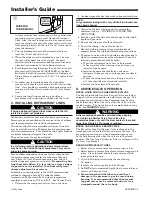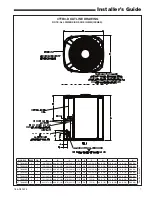
ALL phases of this installation must comply with NATIONAL, STATE AND LOCAL CODES
IMPORTANT — This Document is customer property and is to remain with this unit. Please return to service
information pack upon completion of work.
Installer’s Guide
These instructions do not cover all variations in
systems nor provide for every possible contingency
to be met in connection with installation. All phases
of this installation must comply with NATIONAL,
STATE AND LOCAL CODES. Should further information
be desired or should particular problems arise which are
not covered sufficiently for the purchaser’s purposes, the
matter should be referred to your installing dealer or local
distributor.
A. GenerAl
WArnInG
!
This information is intended for use by individuals pos ses
s ing adequate backgrounds of electrical and mechanical
experience. Any attempt to repair a central air condition ing
product may result in personal injury and or property damage.
The manufacturer or seller cannot be respon sible for the
interpretation of this information, nor can it assume any liability
in connection with its use.
NOTICE:
Trane has always recommended installing Trane
approved matched indoor and outdoor systems.
The benefits of installing approved matched systems
are maximum efficiency, optimum performance and
best overall system reliability.
WArnInG
!
These units use r410A refrigerant which operates at 50 to 70%
higher pressures than r22. Use only r410A approved service
equipment. refrigerant cylinders are painted a “rose” color to
indicate the type of refrigerant and may contain a “dip” tube to
allow for charging of liquid refrigerant into the system. All r410A
systems use a POe oil that readily absorbs moisture from the
atmosphere. To limit this “hygroscopic” action, the system should
remain sealed whenever possible. If a system has been open to
the atmosphere for more than 4 hours, the compressor oil must
be replaced. never break a vacuum with air and always change
the driers when opening the system for component replacement.
For specific handling concerns with r410A and POe oil,
reference retrofit Bulletin
SSCAPG011en.
Check for transportation damage after unit is uncrated.
Report promptly, to the carrier, any damage found to the
unit.
To determine the electrical power requirements of the unit,
refer to the nameplate of the unit. The electrical power
available must agree with that listed on the nameplate.
Condensing Units
4TTB3D
18AC80D12
B. lOCATIOn AnD PrePArATIOn
OF The UnIT
1. When removing unit from the pallet, notice the tabs on
the basepan. Remove tabs by cutting with a sharp tool
as shown in Figure 2 (see page 2).
2. The unit should be set on a level support pad at least
as large as the unit base pan, such as a concrete
slab. If this is not the application used please refer to
application bulletin SSC-APG002-EN.
3. The support pad must NOT be in direct contact with
any structure. Unit must be positioned a minimum
of 12" from any wall or surrounding shrubbery to
insure adequate airflow. Clearance must be provided
1
5 FT. ABOVe UnIT — UnreSTrICTeD
CAUTIOn
!
UnIT COnTAInS r410A reFrIGerAnT!
R-410A OPERATING PRESSURE EXCEEDS THE
LIMIT OF R-22. PROPER SERVICE EQUIPMENT IS
REQUIRED. FAILURE TO USE PROPER SERVICE
TOOLS MAY RESULT IN EQUIPMENT DAMAGE OR
PERSONAL INJURY.
SerVICe
USE ONLY R-410A REFRIGERANT AND
APPROVED POE COMPRESSOR OIL.


























